Coronavirus (COVID-19): modelling the epidemic (issue no. 22)
Latest findings in modelling the COVID-19 epidemic in Scotland, both in terms of the spread of the disease through the population (epidemiological modelling) and of the demands it will place on the system, for example in terms of health care requirement
This document is part of a collection
Coronavirus (COVID-19): modelling the epidemic in Scotland (Issue No. 22)
Background
This is a report on the Scottish Government modelling of the spread and level of Covid-19. This updates the previous publication on modelling of Covid-19 in Scotland published on 14 October 2020. The estimates in this document help the Scottish Government, the health service and the wider public sector plan and put in place what is needed to keep us safe and treat people who have the virus.
This edition of the research findings focuses on the epidemic as a whole, looking at estimates of R, growth rate and incidence.
Key Points
- The reproduction rate R in Scotland is currently estimated as being between 1.3 and 1.6.
- The number of new daily infections for Scotland is estimated as being between 96 and 347, per 100,000 people.
- The growth rate for Scotland is estimated as being between +6% and +9%.
- The estimated doubling time for Scotland was between 8 and 10 days.
- There was a significant increase in contacts when the schools went back (from just below 6 to 8 per day). However, the number of contacts has fallen significantly in the last two weeks (down around 19%), and is now slightly lower than the level immediately before the schools returned.
- There has also been a drop off in how many people are visiting different locations, particularly other homes in recent weeks. This suggests the rule of six and restrictions on households meeting are having some effect which it is hoped will feed through to confirmed cases over the next few weeks.
Overview of Scottish Government Modelling
Epidemiology is the study of how diseases spread within populations. One way we do this is using our best understanding of the way the infection is passed on and how it affects people who catch it to create mathematical simulations. Because people who catch Covid-19 have a relatively long period in which they can pass it on to others before they begin to have symptoms, and the majority of people infected with the virus will experience mild symptoms, this “epidemiological modelling” provides insights into the epidemic that cannot easily be measured through testing e.g. of those with symptoms, as it estimates the total number of new daily infections and infectious people, including those who are asymptomatic or have mild symptoms.
Modelling also allows us to make short-term forecasts of what may happen with a degree of uncertainty. These can be used in health care and other planning. The modelling in this research findings is undertaken using different types of data which going forward aims to both model the progress of the epidemic in Scotland and provide early indications of where any changes are taking place.
Modelling outputs are provided here on the current epidemic in Scotland as a whole, based on a range of methods. Because it takes a little over three weeks on average for a person who catches Covid-19 to show symptoms, become sick, and either die or recover, there is a time lag in what our model can tell us about any re-emergence of the epidemic and where in Scotland this might occur. However modelling of Covid deaths is an important measure of where Scotland lies in its epidemic as a whole. In addition the modelling groups which feed into the SAGE consensus use a range of other data along with deaths in their estimates of R and growth rate. These outputs are provided in the first part of this research findings. The type of data used in each model to estimate R is highlighted in Figure 2.
A short term forecast of the number of cases in the next two weeks is also provided, as the focus at this stage of the epidemic is the re-emergence of the virus in Scotland rather than whether there is sufficient hospital capacity to treat large numbers of Covid cases.
What the modelling tells us about the epidemic as a whole
Figure 1 shows how Rt has changed since February. Before the “stay at home” restrictions were put in place Rt was above 1, and most likely to have been between 3 and 4 before any interventions were put in place.
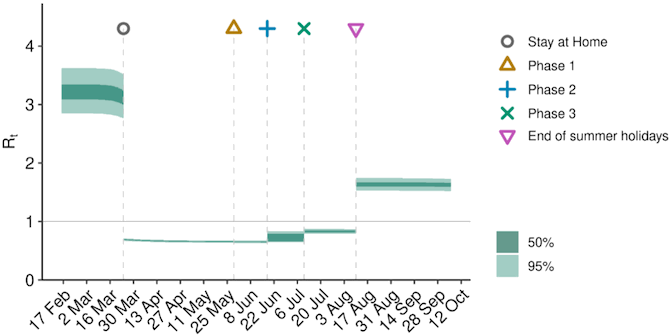
Source: Scottish Government modelled estimates using Imperial College model code; actual data from https://www.nrscotland.gov.uk/statistics-and-data/statistics/statistics-by-theme/vital-events/general-publications/weekly-and-monthly-data-on-births-and-deaths/deaths-involving-coronavirus-covid-19-in-scotland
The various groups which report to the Scientific Pandemic Influenza Group on Modelling (SPI-M) use different sources of data in their models (i.e. deaths, hospital admissions, cases) so their estimates of R are also based on these different methods. SAGE’s consensus view across these methods, as of 14 October, was that the value of Rt in Scotland was above 1, between 1.3 and 1.6, meaning that the epidemic is growing exponentially. The R value estimated by the Scottish Government falls within this range, and is similar to the estimates of other modelling groups (Figure 2).
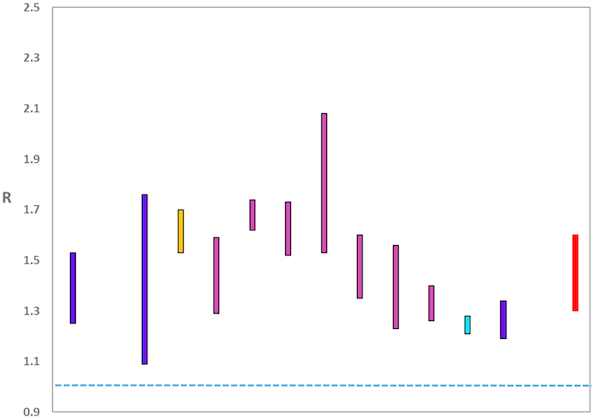
Source: Scientific Advisory Group for Emergencies (SAGE).
On 13 October, Public Health Scotland recorded 1,297[1] positive new cases, with 7,550 positive new cases over the week of 7 – 13 October.
The various groups which report to the Scientific Pandemic Influenza Group on Modelling (SPI-M) use different sources of data in their models to produce estimates of incidence. SPI-M’s consensus view across these methods, as of 14 October, was that the incidence of new daily infections in Scotland was between 96 and 347 new infections per 100,000. This equates to between 5,200 and 18,900 people becoming infected each day in Scotland.
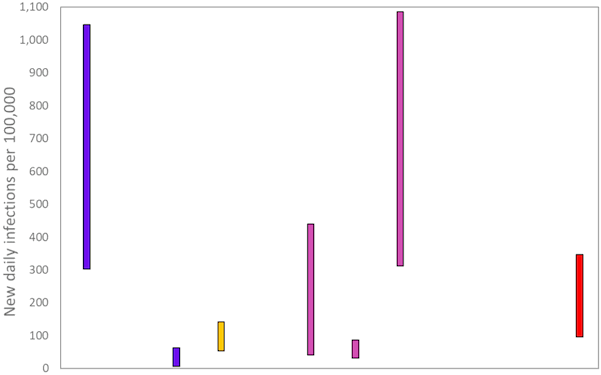
Source: Scientific Pandemic Influenza Group on Modelling (SPI-M).
The consensus from SAGE for this week is that the growth rate in Scotland is between +6% and +9% per day. Last week the growth rate was also in the range +6% to +9%.
The spread of the epidemic can be expressed in terms of the length of time it takes for numbers of new daily cases to double. Doubling times were provided by SPI-M on 14 October. The consensus estimated doubling time for Scotland was between 8 and 10 days.
Figure 4 shows the epidemiological model forecasts of daily deaths produced by the Scottish Government, given the present set of interventions. This measure of the epidemic is forecast to increase in the weeks ahead.
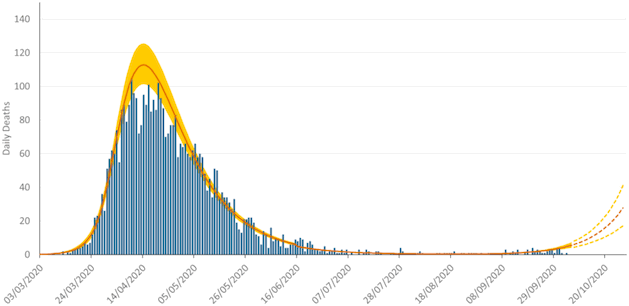
Source: Scottish Government modelled estimates using Imperial College model code; actual data from https://www.nrscotland.gov.uk/statistics-and-data/statistics/statistics-by-theme/vital-events/general-publications/weekly-and-monthly-data-on-births-and-deaths/deaths-involving-coronavirus-covid-19-in-scotland
The logistical model developed by Scottish Government analysts to assess implications for health care demand (see previous Research Findings) has been adapted to produce a short-term forecast of cases.
The following two week ahead predictions use this model to extend the estimated number of infections from the Imperial College model, in a manner that fits with the estimated number of actual cases, adjusting positive tests to account for asymptomatic and undetected infections. The extension begins in mid-July, and assumes an Rt value rising to 1.6. Future Rt values are based on agreed assumptions.
Figure 5 shows two predictions from this model - a “better scenario”, which assumes the current Rt value was reduced significantly as a result of measures announced on 7 October, and a “worse scenario”, which assumes that transmission decreased only by a small amount.
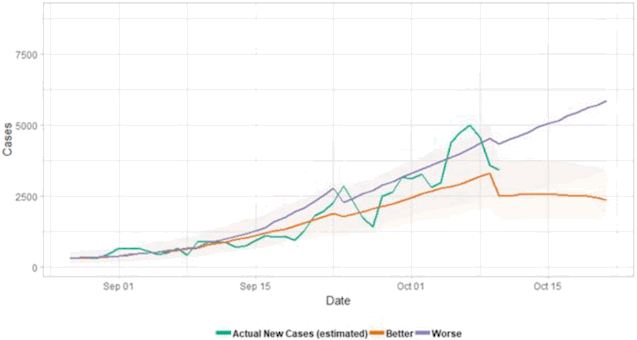
What we know about how people’s contact patterns have changed
It is now possible for us to estimate how much contact people in Scotland have with each other, with a good degree of accuracy. This provides an update of the modelled results presented in issue 18 using methodologies developed by the London School of Hygiene and Tropical Medicine. The modelling is based on a survey asking about where respondents have been and how many contacts they met in a given week.
The average number of contacts per day are around twice the level at the beginning of Stay-at-home-advice, and around a third of the level pre-Stay-at-home-advice (UK comparison). There was a significant increase in contacts when the schools went back (from just below 6 to 8 per day). However, the number of contacts has fallen significantly in the last two weeks (down around 19%), and is now slightly lower than the level immediately before the schools returned (Figure 6). There has also been a drop off in how many people are visiting different locations, particularly other homes in recent weeks. This suggests the rule of six and restrictions on households meeting are having some effect which it is hoped will feed through to confirmed cases over the next few weeks.
From the results older people generally have fewer contacts than younger people, but the difference is largely from work and school contacts, rather than in the home or in other settings.
The mean number of contacts per person in the latest wave (1 to 7 October) of the SCS has reduced slightly as shown in Figure 6, though it remains significantly higher than the 2.8 contacts per person for the UK as a whole at the beginning of Stay-at-home-advice.
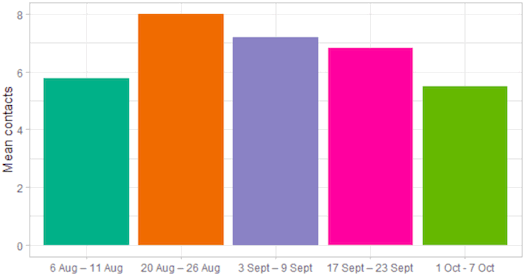
As shown in Figure 7, contacts are fewer in older age groups, with the oldest age group having similar levels of contact to the UK during Stay-at-home-advice (2.0 from CoMix), and the youngest age group having similar levels of contact to the UK average prior to Stay-at-home-advice (12.1 from POLYMOD[2]) until mid-September, although this has fallen significantly in the most recent survey.
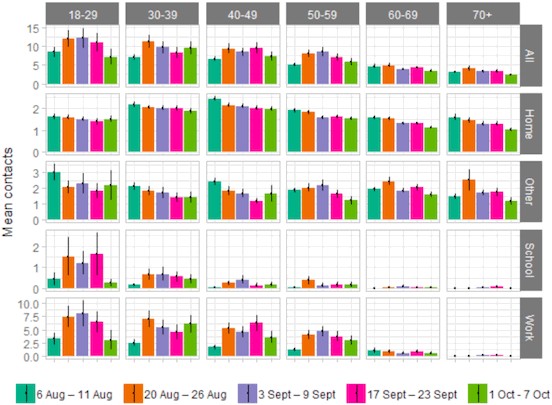
The main difference between age groups is that younger people are having more contacts at work and at school. There is little age difference in contacts reported in “other” settings at around 1.5 contacts per day, and the youngest and oldest age groups also report similar contacts in the home (the middle age groups report higher contacts in the home than the youngest and oldest) as set out in Figure 7.
As Figure 8 shows, there has been a steady reduction in the proportion of people that have visited other people’s home since the first wave of the survey. This is also reflected in the mean contacts in the home in Figure 7. This will not have been entirely due to the restrictions on meeting in houses, which was introduced on Monday 21 September, as the fourth survey wave was ending, but the trend did continue in the most recent survey wave.
There had been a slight increase in the number of people travelling to work and to gyms and sports clubs, but this has reduced again in the most recent wave (after the introduction of the rule of six and meeting in other’s households on 22/23 September).
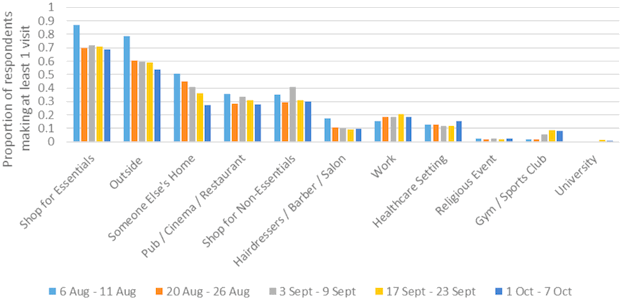
Exceedance is a tool which helps us to spot hotspots of Covid where the number of new cases exceeds what was expected. As cases rise across the country, it becomes less informative as the background level of expected cases increases. As a result, this will not be reported this week.
What next?
The Scottish Government continues to work with a number of academic modelling groups to develop other estimates of the epidemic in Scotland.
The modelled estimates of the numbers of new cases and infectious people will continue to be provided as measures of the epidemic as a whole, along with measures of the current point in the epidemic such as exceedance. Rt and growth rate will also be provided. Further information can be found at https://www.gov.scot/coronavirus-covid-19.
Contact
There is a problem
Thanks for your feedback